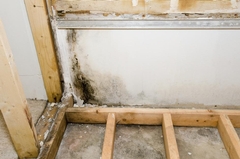
Mold can be a homeowner's worst nightmare. It thrives in damp, humid conditions and can cause significant damage to property while posing health risks to occupants. Did you know that mold spores are present in almost every indoor and outdoor environment? Although these microscopic particles are usually harmless at low levels, they can multiply rapidly under favorable conditions, leading to serious infestations. For residents of Racine, WI, where humidity is often high, understanding effective mold remediation is essential.
This blog post will delve into the importance of proper mold remediation practices, highlight the top five mistakes to avoid, and offer insights into securing long-term success against mold growth. These preventative strategies are crucial for safeguarding your home and health.
Whether you're a homeowner dealing with a minor outbreak or an industry professional seeking best practices, the following sections will equip you with the knowledge and tools to manage mold effectively. Stay engaged as we explore real-world examples, actionable tips, and solutions that align with RestoreMore's expertise in Water, Fire, and Mold Damage Restoration services.
Mistake 1: Ignoring Early Signs of Mold Infestation
The Importance of Early Detection
Early detection often makes the difference between a manageable situation and an extensive restoration project. Unfortunately, many homeowners dismiss small signs of mold, assuming that what they cannot see cannot harm them. This complacency can lead to costly remediation efforts and health issues, ranging from allergies to respiratory problems.
Real-World Example: Homeowners' Oversight
In an example case, a family noticed a musty odor and minor discoloration on their bathroom wall but ignored it. Months later, they faced a widespread mold infestation that not only required professional remediation but also significant renovation. This example underscores the significance of addressing mold promptly.
Actionable Tips for Early Detection
- Regularly inspect areas prone to moisture, such as bathrooms and basements.
- Address leaks or water damage immediately.
- Use a hygrometer to monitor indoor humidity levels, keeping it below 60%.
Mistake 2: Opting for Inappropriate DIY Solutions
Why DIY isn't Always the Answer
While DIY methods can be tempting as a cost-saving measure, they often prove ineffective against significant mold problems. Common household products like bleach may clean surface stains but fail to address the root cause, allowing mold to return.
Real-World Example: The DIY Downfall
A homeowner attempted to eliminate mold with household cleaners, resulting in temporary relief but a rapid resurgence. Ultimately, professional intervention was required to eradicate the infestation completely, costing more than initial professional estimates.
Professional Expertise Leads to Lasting Results
- Trust professionals like those at RestoreMore for comprehensive inspections and remediation.
- Professionals use advanced techniques and equipment like HEPA vacuuming and antimicrobial applications.
Mistake 3: Overlooking Moisture Sources
Understanding Mold's Dependency on Moisture
Mold needs moisture to thrive, making unresolved water issues a perpetual risk for recurrence. Ignoring the underlying causes, such as hidden leaks or inadequate ventilation, ensures mold's return.
Real-World Example: The Cost of Neglect
Consider a commercial property in Racine that frequently dealt with mold due to a hidden plumbing leak. The property manager's failure to address the leak led to repeated mold outbreaks, resulting in tenant dissatisfaction and financial loss.
Identifying and Addressing Moisture Sources
- Inspect and repair plumbing leaks promptly.
- Install proper ventilation in high-moisture areas, like kitchens and bathrooms.
- Consider using dehumidifiers in basements and other damp areas.
Mistake 4: Skipping Post-Remediation Verification
The Need for Thorough Verification
After remediation efforts, it's vital to confirm that mold levels have returned to normal. Failing to do so can lead to a false sense of security, with problems reemerging soon after.
Real-World Example: False Security
Following a DIY attempt at mold removal, a couple deemed their home mold-free without proper verification. Days later, their issues resurfaced, requiring professional re-evaluation and additional remediation.
Effective Verification Practices
- Use professional testing services to confirm complete mold removal.
- Set up ongoing moisture and air quality monitoring.
- Regularly assess susceptible areas for signs of mold.
Mistake 5: Neglecting Routine Maintenance
Preventive Maintenance as a Long-Term Solution
Preventive maintenance is your best defense against mold. However, many homeowners only react to mold emergencies instead of adhering to a proactive approach.
Real-World Example: The Power of Prevention
In contrast, a proactive homeowner set up bi-annual maintenance checks. This approach caught a minor mold growth early, preventing a large-scale outbreak and saving significant costs.
Establishing a Maintenance Routine
- Schedule regular inspections with a reliable provider like RestoreMore.
- Implement routine cleaning protocols in moisture-prone areas.
- Educate family members on signs of water damage and mold.
What Can Be Done?
Mold remediation is not just about eradicating visible mold; it's about understanding the underlying issues and implementing strategies to prevent recurrence. By avoiding common mistakes and adhering to best practices, you can protect both your investment and your health.
If you suspect mold problems or require assistance in Milwaukee or surrounding regions, explore RestoreMore's mold removal and mold remediation services or contact us for a comprehensive evaluation and peace of mind.